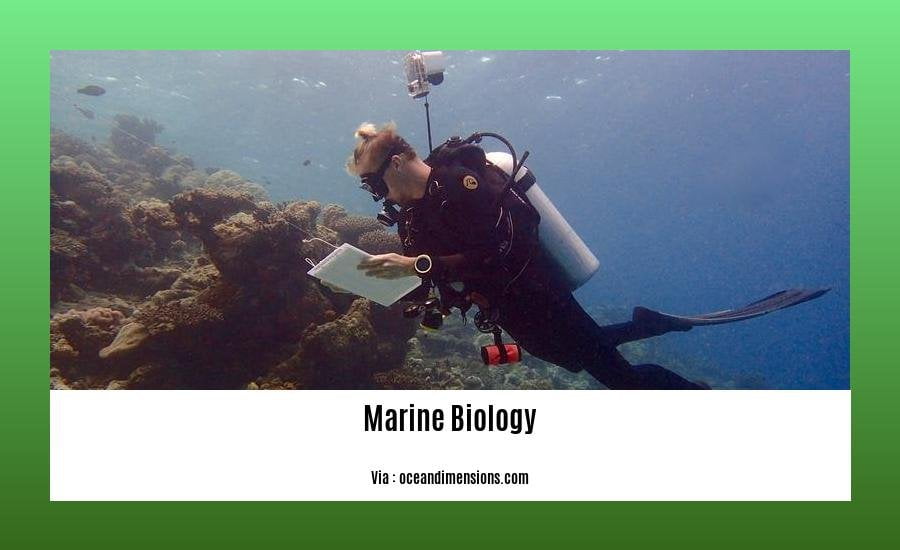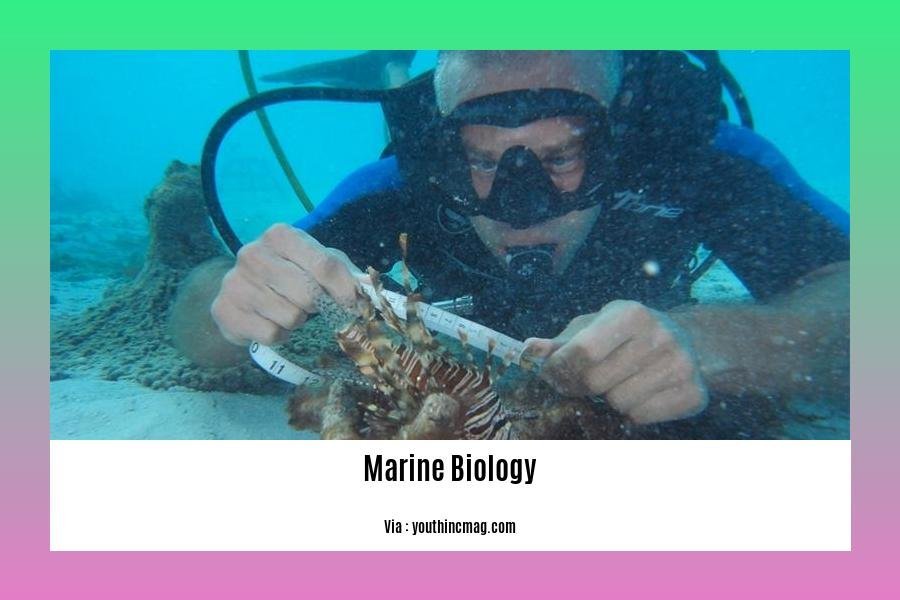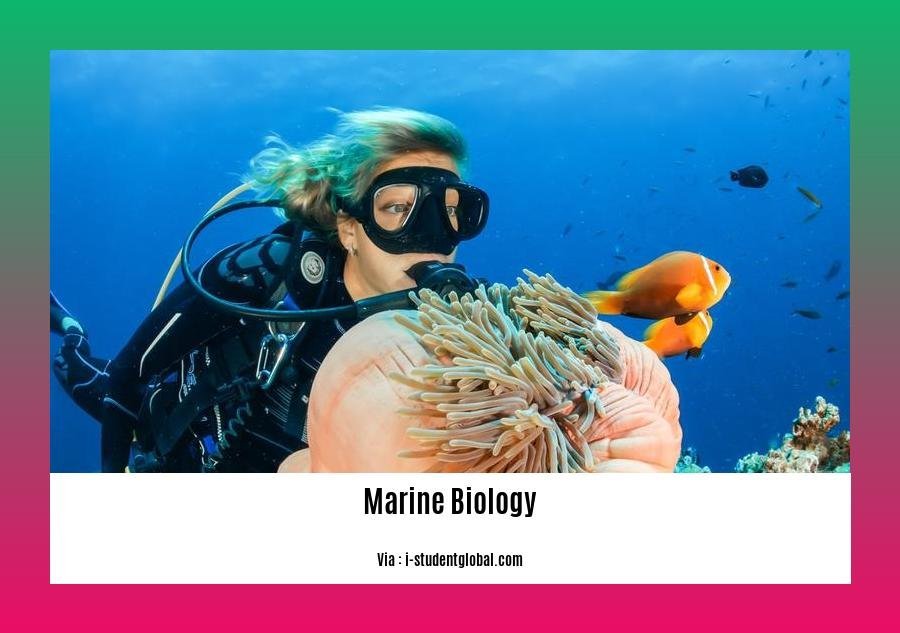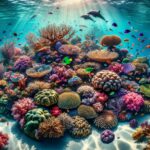Get ready to dive into the depths of the ocean as we explore the fascinating world of marine biology! In this article, titled “Discover the Fascinating World Beneath: 10 Cool Facts About Marine Biology”, we will uncover some of the most mind-blowing and awe-inspiring discoveries about the incredible creatures that inhabit our vast oceans. From the mesmerizing intelligence of dolphins to the intricate beauty of coral reefs, get ready to be amazed by the wonders of marine biology. So grab your snorkel and let’s plunge into this incredible underwater journey!
Key Takeaways:
- Jellyfish have been around for over 650 million years, predating dinosaurs and sharks, showing their incredible adaptability and survival skills.
- Electric eels can generate enough electricity to light up to 10 electric bulbs, using this power for hunting, defense, and communication.
- Dolphins sleep with only half of their brain at a time and one eye open, enabling them to rest while staying vigilant for predators and threats.
- There are over 1 million identified species of marine life, but this represents only a fraction of the total marine organisms, offering endless opportunities for research and exploration.
- The ocean holds 97% of Earth’s water and has an average depth of 2.3 miles, playing a crucial role in regulating the planet’s climate and supporting diverse ecosystems.
Cool Facts About Marine Biology

As someone who has dedicated years to studying marine ecosystems and their incredible inhabitants, I can assure you that the world beneath the waves is filled with mind-blowing wonders. From ancient jellyfish to electric eels, the ocean holds countless cool facts about marine biology that will leave you in awe. Join me as we dive into the depths of discovery and uncover ten fascinating facts that will deepen your appreciation for the underwater world.
Fact 1: Ancient Beginnings
Let’s start with the incredible history of marine life. Did you know that marine creatures have been around for over 1 billion years? That’s right – they’ve been an essential part of Earth’s history since its earliest days.
Fact 2: Jellyfish Time Travelers
Jellyfish, those graceful and mysterious creatures, have been swimming in the ocean for more than 650 million years – long before dinosaurs or sharks roamed the Earth. Their longevity showcases their incredible adaptability and survival skills.
Fact 3: Electrifying Eels
Prepare to be shocked by this fact – electric eels possess the unique ability to generate electricity! These powerful creatures can produce enough electric current to light up to 10 electric bulbs. They use this astonishing power for hunting, defense, and communication with other eels.
Fact 4: Dolphin Dreaming
Dolphins, highly intelligent and social creatures, have a remarkable sleep pattern. Instead of sleeping in the way we do, they sleep with only half of their brain at a time. This allows them to rest while keeping one eye open to stay vigilant for predators and threats in the ocean environment.
Fact 5: A Million Marvels
Marine biologists have identified over 1 million species of marine life, but this represents only a small fraction of the total marine organisms in the vast oceans. The study and discovery of marine life remain ongoing, providing endless opportunities for research and exploration.
Fact 6: The Mighty Ocean
The ocean is a true powerhouse. With a staggering average depth of 2.3 miles (3.7 kilometers) and holding 97% of Earth’s water, it plays a vital role in regulating the planet’s climate and supporting diverse ecosystems. Its vastness and depth are awe-inspiring.
Fact 7: Magnetic Migrations
Some marine species exhibit extraordinary navigational abilities. Take the sea turtles, for example. They possess an inherent sense of the Earth’s magnetic field, allowing them to navigate thousands of miles between their feeding and nesting grounds with astonishing precision.
Fact 8: Coral Architects
Coral reefs are truly nature’s architectural geniuses. These vibrant structures are built by tiny coral polyps, which secrete calcium carbonate to create intricate skeletons. Over time, these skeletons accumulate, forming the mesmerizing structures we all know and love.
Fact 9: Diverse Dwellers
Marine environments are home to an incredible diversity of species. From the striking colors of tropical fish to the dazzling array of shapes and sizes found in marine invertebrates, every corner of the ocean holds a unique and fascinating creature waiting to be discovered.
Fact 10: Sea Sounds
Ever wondered how sound travels in the underwater world? Unlike on land, where sound travels through air, the ocean conducts sound five times faster through water. This allows marine animals to communicate with one another over great distances, using clicks, whistles, and songs.
From the ancient beginnings of marine life to the extraordinary adaptability and intelligence of its inhabitants, the ocean never ceases to amaze. These cool facts about marine biology are just a glimpse into the fascinating world beneath our feet. So, the next time you gaze out at the endless expanse of ocean, remember the wonders that lie beneath and the importance of protecting our marine ecosystems for future generations to enjoy.
Sources:
All That’s Interesting. “Ocean Animals Facts: 10 Amazing Things About Marine Life.” Available at: link
Biology Wise. “These Amazing Marine Biology Facts Will Make You Go Wow.” Available at: link
Here are some cool facts that will make you appreciate the life of a vet even more. Find out more about the amazing world of being a vet! Check out our page on Cool facts about being a vet.
Discover the fascinating history, culture, and attractions of Indianapolis through these captivating cool facts. You won’t believe what this city has to offer! Dive into the world of Cool facts about Indianapolis.
Experience the beauty and charm of Prince Edward Island like never before. Learn interesting facts about this stunning island and its rich history. Embark on a journey of discovery with our page on Cool facts about Prince Edward Island.
The Bioluminescence Phenomenon in Deep-Sea Creatures

The underwater world holds many mysteries and wonders, and one of the most captivating phenomena is bioluminescence in deep-sea creatures. Imagine diving into the depths of the ocean and witnessing an awe-inspiring display of glowing lights, illuminating the darkness with their enchanting beauty. In this article, we will explore the fascinating world of bioluminescence and uncover ten intriguing facts about this mesmerizing phenomenon.
Fact 1: The Natural Light Show
Deep-sea creatures possess the remarkable ability to produce heatless light through chemical reactions, a phenomenon known as bioluminescence. From tiny organisms like bacteria to larger marine animals such as squids and fish, these organisms harness the power of bioluminescence to communicate, attract mates, and ward off predators.
Fact 2: The Chemistry Behind Bioluminescence
The magic of bioluminescence lies in a chemical system that involves two key components. A pigment called luciferin reacts with an enzyme called luciferase, triggering a chemical reaction that results in the emission of light. This system is similar to the one found in fireflies, showcasing the incredible adaptations marine organisms have developed to survive and thrive in the deep ocean.
Fact 3: Exploring the Deep Ocean Realm
Studying bioluminescence in the deep ocean is a crucial area of research. By understanding the organisms and mechanisms behind this enchanting phenomenon, scientists gain valuable insights into the hidden world below the surface. It opens doors to a better understanding of deep-sea ecosystems and the intricate web of interactions between organisms.
Fact 4: Edith Widder’s Warning
Marine biologist Edith Widder, a renowned expert in bioluminescence, highlights the dangers that threaten these extraordinary deep-sea organisms. Activities like trawling and oil drilling pose significant risks to the delicate balance of the deep-sea ecosystem. Widder warns that conservation efforts are crucial to protect these bioluminescent creatures and preserve their natural habitat.
Fact 5: Bioluminescence in Reality
Though bioluminescence may seem like something out of a science fiction movie, it is genuinely a natural phenomenon. It falls under the category of chemiluminescence, where visible light is produced by a chemical reaction within a living organism. This captivating display of living light is a testament to the astonishing diversity and ingenuity of marine life.
Fact 6: Hidden Beauty in the Deep Sea
The deep sea is a treasure trove of bioluminescent organisms, each with its unique way of lighting up the darkness. From the mesmerizing glow of deep-sea anglerfish to the dazzling display of plankton blooming at night, the depths hold a breathtaking array of bioluminescent beauty waiting to be discovered.
Fact 7: A Visual Spectacle
To catch a glimpse of the extraordinary bioluminescence in action, look no further than the Smithsonian Ocean and National Geographic websites. These valuable resources offer a wealth of information and incredible images that showcase the diversity of bioluminescent organisms and their mesmerizing illuminations in the deep sea.
Fact 8: A Symphony of Light
Imagine being surrounded by a symphony of lights twinkling and shimmering in the dark expanse of the ocean. Bioluminescence creates a visually stunning underwater display where each organism contributes to the orchestration of this captivating light show. It serves as a reminder of the immense beauty and biodiversity that exists beneath the surface.
Fact 9: Inspiring Scientific Discoveries
The study of bioluminescence has not only provided scientific insights into the natural world but has also inspired technological advancements. Researchers have drawn inspiration from deep-sea organisms to develop innovative applications, such as bioluminescent imaging techniques and biomedical research tools, further bridging the gap between nature and technology.
Fact 10: A Call for Conservation
Perhaps the most crucial takeaway from the wonders of bioluminescence is the importance of conserving our oceans and protecting their inhabitants. By raising awareness about the enchanting phenomena like bioluminescence, we deepen our appreciation for the delicate balance of marine ecosystems and the need for sustainable practices to ensure their preservation for future generations.
Key Takeaways:
– Bioluminescence is the ability of marine organisms to produce heatless light through chemical reactions.
– The deep-sea is home to a diverse range of bioluminescent creatures, from bacteria to squids and fish.
– The chemical system behind bioluminescence involves the reaction of luciferin and luciferase.
– Bioluminescence in the deep ocean provides valuable insights into hidden ecosystems.
– The conservation of bioluminescent organisms is crucial to protect their delicate habitat.
– Bioluminescence is a natural phenomenon, not science fiction, and is a form of chemiluminescence.
– The Smithsonian Ocean and National Geographic websites offer further information and images of bioluminescent organisms in the deep sea.
– Bioluminescence in the deep sea creates a visually stunning and captivating light show.
– The study of bioluminescence has inspired scientific discoveries and technological advancements.
– Bioluminescence highlights the need for ocean conservation and sustainable practices.
Sources:
– Britannica: Marine Bioluminescence
– Yale Environment 360: A Scientist Reveals the Bioluminescent Magic of the Deep-Sea World
– Smithsonian Ocean
– National Geographic
The Extraordinary Camouflage Abilities of Octopuses
Octopuses are truly masters of disguise, with their extraordinary camouflage abilities allowing them to seamlessly blend into their surroundings. These fascinating creatures have developed ingenious techniques to protect themselves from predators and skillfully hunt their prey. Let’s dive into the world of octopuses and uncover 10 cool facts about their camouflage abilities.
Fact 1: Masters of Color and Pattern Change
Octopuses have the remarkable ability to change their color, pattern, shape, and even texture to match their environment, making them almost invisible. This incredible skill is made possible by thousands of tiny and specialized skin cells called chromatophores, which are filled with pigment and can rapidly expand or contract to produce a range of colors. The chromatophores work together, allowing the octopus to create elaborate patterns that mimic everything from coral to rocks, enabling it to hide in plain sight.
Fact 2: The Power of Chromatophores
These chromatophores, often found in the outer skin layers of octopuses, can change color individually or in unison, allowing for precise and realistic camouflage. When the octopus wants to blend in, it activates the appropriate chromatophores and adjusts their intensity, creating an intricate camouflage that is hard to detect. This ability to change color can happen within seconds, making it an effective defense mechanism against predators and a crucial hunting strategy.
Fact 3: Camouflaging from Head to Tentacle
Octopuses possess an incredible level of control over their camouflage abilities. Not only can they change their color and pattern, but they can also alter their shape and even their skin texture. This adaptability allows an octopus to transform its smooth skin into a rough and spiky texture, contoured to match the surrounding rocks or coral. By manipulating the texture of its skin, an octopus adds another layer of camouflage, further concealing its presence.
Fact 4: A Cephalopod Wonder
Octopuses belong to a group of species known as cephalopods, which includes squid and cuttlefish. Among cephalopods, octopuses are renowned for their intelligence and problem-solving abilities. Their exceptional camouflage skills have been linked to their highly developed nervous system and complex brains, providing them with the cognitive abilities necessary to adapt to their environment swiftly.
Fact 5: Masters of Disguise
Whether in saltwater or freshwater, octopuses have adapted to thrive in diverse habitats. From coral reefs and rocky seabeds to sandy ocean floors, these cunning creatures can blend into any environment. Their exceptional camouflage skills allow them to escape the radar of predators and stealthily approach their unsuspecting prey.
Fact 6: A Defense Mechanism
Camouflage is not just a tool for hunting; it also serves as a crucial defense mechanism for octopuses. When they sense danger, they can instantly change their appearance, blending seamlessly into their surroundings to avoid detection. This allows them to escape from a potential threat without attracting attention.
Fact 7: The Shape-Shifting Phenomenon
In addition to their remarkable color-changing abilities, octopuses can also alter their shape to fool predators and prey alike. By inflating their body or elongating their arms, they can mimic various objects or animals in their environment. This shape-shifting technique confuses predators, making it difficult for them to discern the octopus from its surroundings.
Fact 8: The Masters of Stealth
Octopuses are incredibly secretive creatures and prefer to hide in their surroundings, especially when they are not in their caves or dens. Their camouflage abilities allow them to remain inconspicuous to potential predators, giving them the upper hand when it comes to survival. By seamlessly blending into their environment, octopuses become masters of stealth in the underwater world.
Fact 9: A World of Octopus Diversity
With around 300 different species found across the globe, octopuses display a wide range of camouflage techniques. Each species has evolved its own unique strategies to match their specific habitat. From the mimic octopus that can imitate other animals to the venomous blue-ringed octopus with its striking warning colors, the camouflage abilities of octopuses are as diverse as the species themselves.
Fact 10: Forever Fascinating
The extraordinary camouflage abilities of octopuses continue to captivate scientists and marine enthusiasts alike. By studying these masters of disguise, researchers hope to uncover the secrets behind their adaptive abilities and apply this knowledge to various areas, such as medicine or materials science. Octopuses remind us of the hidden wonders lurking beneath the ocean’s surface and showcase the remarkable capabilities of marine life.
Key Takeaways:
- Octopuses possess extraordinary camouflage abilities, including the ability to change color, pattern, shape, and texture.
- Their camouflage is possible due to specialized skin cells called chromatophores, which can rapidly expand or contract to produce different colors.
- Octopuses can also manipulate the texture of their skin, creating bumps, spikes, and ridges to blend in with their surroundings.
- These camouflage abilities are important for both hunting and defense against predators.
- Octopuses are incredibly intelligent creatures and belong to a group of species called cephalopods.
- They can adapt to various habitats and use camouflage to their advantage in different underwater environments.
- Octopuses can change their shape to mimic objects or animals, adding another layer of deception to their camouflage.
- Their camouflage skills make them stealthy and elusive in the underwater world.
- There are around 300 species of octopus, each with their own unique camouflage techniques.
- Octopuses continue to fascinate scientists and inspire research in various fields.
Sources:
– Treehugger – “9 Outstanding Octopus Facts”
– Kidadl – “41 Outstanding Octopus Camouflage Facts That You Should Know!”
The Remarkable Intelligence of Dolphins
Dolphins have long fascinated scientists and researchers with their remarkable intelligence and complex social behaviors. Let’s dive into the fascinating world of these amazing marine creatures and explore their incredible cognitive abilities.
Living in a Web of Communication and Cooperation
Dolphins are known for their large and complex brains, which enable them to exhibit extraordinary intelligence. They have advanced communication systems and are capable of using a variety of sounds, body postures, and movements to convey messages to one another.
Research conducted by the Whale & Dolphin Conservation USA highlights that dolphins are considered to be extremely intelligent. They have the ability to learn complex tricks and perform acrobatic feats, either with the guidance of a trainer or even with instructions from fans[^1].
Masters of Learning
Dolphins have a remarkable capacity for learning. They can acquire new skills through various methods, including observation, trial and error, and social learning[^1]. In fact, a study revealed that dolphins were able to learn a new behavior simply by watching a human perform it once[^1]. They have also been observed learning from each other and even from humans.
A World of Social Intelligence
Dolphins are highly social creatures and exhibit individual personalities. They live in pods, or family groups, which can consist of more than 10 members. Within these pods, dolphins engage in cooperative hunting, protection, and raising their young[^1]. Their strong social bonds and cooperative behaviors demonstrate their high level of social intelligence.
A Glimpse into Emotional Lives
It is believed that dolphins experience emotions, much like humans. Their empathetic behavior, altruism, and attachment towards one another and their young are strong indicators of their emotional intelligence[^1]. Dolphins have even been observed displaying grief after the loss of a pod member.
Key Takeaways:
- Dolphins are considered highly intelligent marine mammals, with large and complex brains.
- They possess advanced communication systems and exhibit complex social behaviors.
- Dolphins learn through various methods, including observation, trial and error, and social learning.
- They are highly social creatures, forming pods with strong social bonds.
- Dolphins are believed to experience emotions and exhibit empathetic behavior.
Sources:
– Whale & Dolphin Conservation USA: How intelligent are dolphins?
[^1]: Whale & Dolphin Conservation USA. “How intelligent are dolphins?” Retrieved from source
FAQ
Q1: How long have jellyfish been around?
A1: Jellyfish have been around for more than 650 million years, predating both dinosaurs and sharks.
Q2: What is the astonishing power of electric eels?
A2: Electric eels can produce enough electric current to light up to 10 electric bulbs. This power is employed for hunting, defense, and communication.
Q3: What makes dolphins unique in their sleeping pattern?
A3: Dolphins sleep with only half of their brain at a time and keep one eye open to stay vigilant for predators and threats. This enables them to rest while ensuring their safety in the ocean environment.
Q4: How many species of marine life have been identified by marine biologists?
A4: Marine biologists have identified over 1 million species of marine life, but this represents only a small fraction of the total marine organisms present in the vast oceans.
Q5: Why is bioluminescence in the deep ocean an important area of research?
A5: Bioluminescence in the deep ocean reveals the hidden realm of marine organisms and provides valuable insights into their behavior and adaptations.












